Demystifying Life Processes: Your Simplified Class 10 Notes (CBSE 2024-25)
Feeling overwhelmed by the intricate details of Life Processes in your CBSE Class 10 Science (Chapter 5)? Fear not, fellow student! This blog post is here to transform your understanding with clear and concise notes.
We've meticulously crafted these notes to simplify complex concepts related to life processes, making them easy to grasp and retain. Whether you're revising for exams or simply aiming for a deeper understanding of this fascinating chapter, this is the perfect resource for you.
Here's the best part: we're offering downloadable PDF notes specifically tailored for the 2024-25 CBSE academic session. So, ditch the bulky textbooks and dive into these simplified notes for a stress-free learning experience!
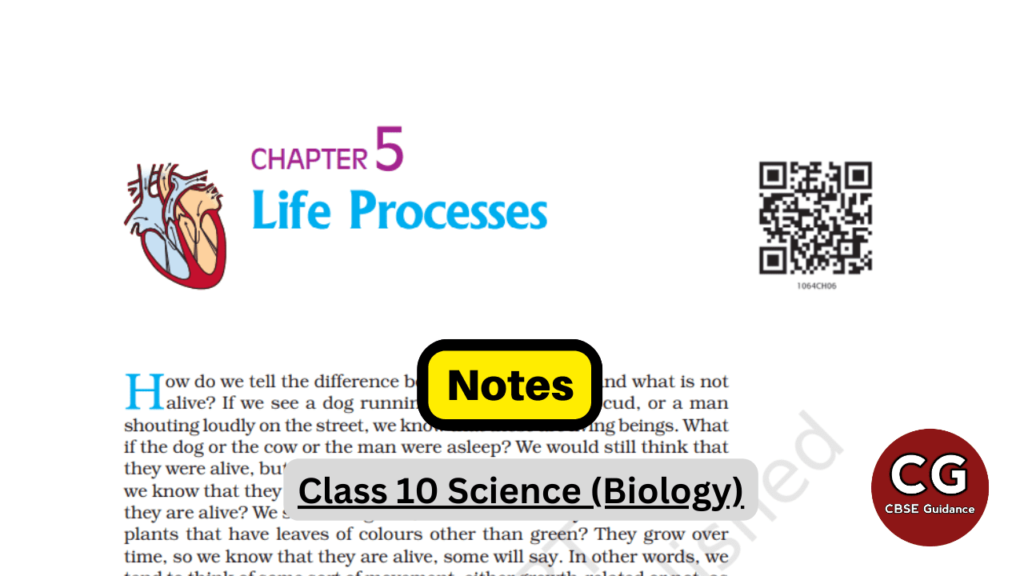
| Subject | Science (Chemistry) |
| Class | 10 |
| Board | CBSE |
| Chapter No. | 5 |
| Chapter Name | Life Processes |
| Type | Notes |
| Session | 2024-25 |
"Education is the passport to the future, for tomorrow belongs to those who prepare for it today."
- Malcolm X
Life Processes Class 10 Notes
Table of Contents
What are Life Processes?
Life Processes: The processes which together perform the repair and maintenance job inside a body are life processes. For Example Respiration (R), Excretion (E), Nutrition (N), and Transportation (T) [RENT].
Nutrition: A process to transfer a source of energy from outside the body of the organism, which we call food, to the inside, is called nutrition.
Respiration: The process of acquiring oxygen from outside the body, and using it in the process of break-down of food sources for cellular needs, is called respiration.
Transportation: A system for carrying food and oxygen from one place to another in the body.
Excretion: The waste by-products are needed to be removed from the body and discarded outside by a process called excretion.
Nutrition
Autotrophs: Some organisms use simple food material obtained from inorganic sources in the form of carbon dioxide and water. For example green plants and some bacteria.
Heterotrophs: Other organisms utilize complex substances. These complex substances have to be broken down into simpler ones before they can be used for the upkeep and growth of the body. To achieve this, organisms use bio-catalysts called enzymes. For example animals and fungi.
Autotrophic Nutrition
- Carbon and energy requirements of the autotrophic organism are fulfilled by photosynthesis.
- Photosynthesis: It is the process by which autotrophs take in substances from the outside and convert them into stored forms of energy. This material is taken in the form of carbon dioxide and water which is converted into carbohydrates in the presence of sunlight and chlorophyll.
- The carbohydrates which are not used immediately are stored in the form of starch.
- Similarly, in our body, some of the energy derived from the food we eat is stored in our body in the form of glycogen.

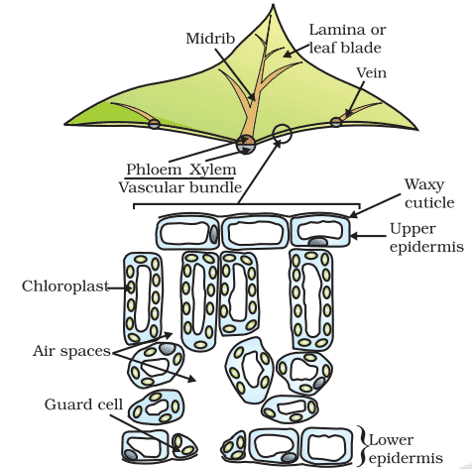
- Events Occurring during Photosynthesis:
- Absorption of light energy by chlorophyll.
- Conversion of light energy to chemical energy.
- Splitting of water molecules into hydrogen and oxygen.
- Reduction of carbon dioxide to carbohydrates.
- Chlorophyll is essential for photosynthesis.
- On Iodine test Blue-black color is obtained on that part of the leaf where photosynthesis occurs.
- How the plant obtains carbon dioxide?
- Massive amounts of gaseous exchange take place in the leaves through stomatal pores for the purpose of photosynthesis.
- The exchange of gases occurs across the surface of stems, roots, and leaves as well.
- Since large amounts of water can also be lost through these stomata, the plant closes these pores when it does not need carbon dioxide for photosynthesis.
- The opening and closing of the pore are a function of the guard cells. The guard cells swell when water flows into them, causing the stomatal pore to open. Similarly, the pore closes if the guard cells shrink.
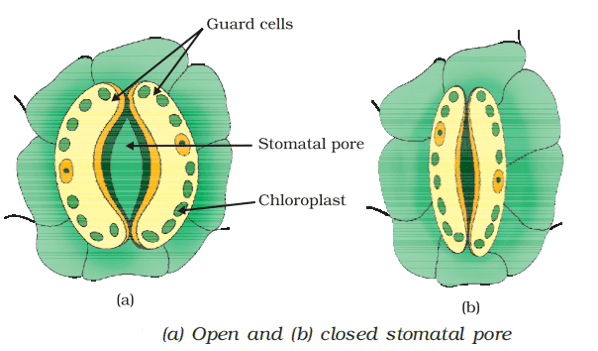
- Experimental setup to prove that Carbon dioxide is essential for photosynthesis:
- KOH is used to absorb Carbon dioxide inside the jar.
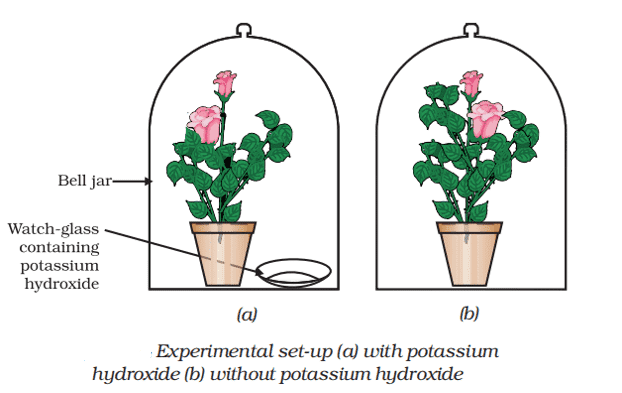
- How other materials are obtained?
- Water is taken from the soil.
- Other materials like nitrogen, phosphorus, iron, and magnesium are taken up from the soil.
- Nitrogen is taken up in the form of inorganic nitrates or nitrites. Or it is taken up as organic compounds which have been prepared by bacteria from atmospheric nitrogen.
Heterotrophic Nutrition
- Saprophytic: Some organisms break down the food material outside the body and then absorb it. Examples are fungi like bread moulds, yeast, and mushrooms.
- Holozoic: Others take in whole material and break it down inside their bodies.
- Parasitic: Some other organisms derive nutrition from plants or animals without killing them. This parasitic nutritive strategy is used by a wide variety of organisms like cuscuta (amar-bel), ticks, lice, leeches, and tape-worms.
How do Organisms obtain their Nutrition?
Single-celled organisms
- Amoeba takes in food using temporary finger-like extensions of the cell surface which fuse over the food particle forming a food-vacuole. Inside the food-vacuole, complex substances are broken down into simpler ones which then diffuse into the cytoplasm. The remaining undigested material is moved to the surface of the cell and thrown out.
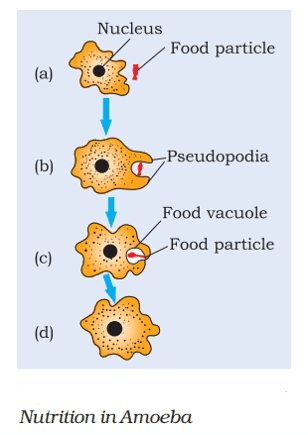
- In Paramoecium, which is also a unicellular organism, the cell has a definite shape and food is taken in at a specific spot. Food is moved to this spot by the movement of cilia which cover the entire surface of the cell.
Nutrition in Human Beings
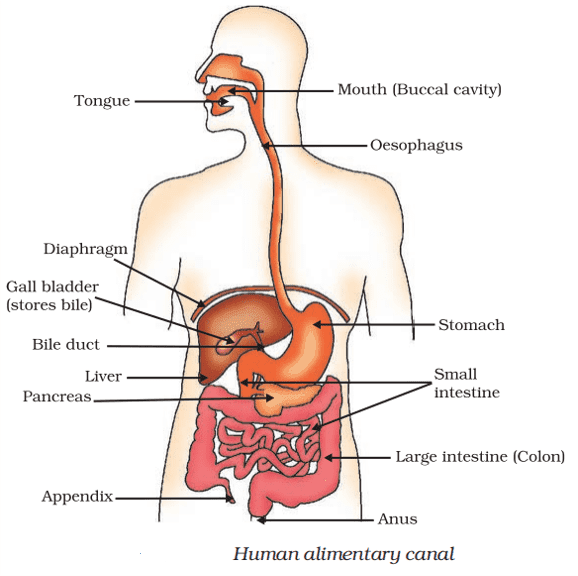
- The alimentary canal is basically a long tube extending from the mouth to the anus.
- Saliva is secreted by the salivary glands.
- The saliva contains an enzyme called salivary amylase that breaks down starch which is a complex molecule to give simple sugar.
- The lining of the canal has muscles that contract rhythmically in order to push the food forward. These peristaltic movements occur all along the gut.
- Digestion in the stomach:
- Gastric glands present in the wall of the stomach release hydrochloric acid, an enzyme called pepsin, and mucus.
- The hydrochloric acid creates an acidic medium that facilitates the action of the enzyme pepsin.
- The mucus protects the inner lining of the stomach from the action of the acid under normal conditions.
- Pepsin is a protein-digesting enzyme.
- The exit of food from the stomach is regulated by a sphincter muscle which releases it in small amounts into the small intestine.
- Length of small intestine:
- Herbivores eating grass need a longer small intestine to allow the cellulose to be digested.
- Meat is easier to digest, hence carnivores like tigers have shorter small intestines.
- The small intestine is the site of the complete digestion of carbohydrates, proteins, and fats.
- It receives the secretions of the liver and pancreas for this purpose.
- The function of Bile juice from the liver:
- The bile salts emulsify fat by acting on large fat globules to break them into smaller globules. This increases the efficiency of pancreatic enzymes.
- The food entering the small intestine is acidic. It is made alkaline by the action of bile juice so as to facilitate the action of pancreatic enzymes.
- The function of pancreatic juice from the pancreas:
- Pancreatic juice contains enzymes like
- trypsin for digesting proteins and
- lipase for breaking down emulsified fats.
- Pancreatic juice contains enzymes like
- The walls of the small intestine contain glands that secrete intestinal juice.
- The enzymes present in it finally convert the
- proteins to amino acids,
- complex carbohydrates into glucose and
- fats into fatty acids and glycerol.
- The inner lining of the small intestine has numerous finger-like projections called villi.
- Functions of Villi:
- Increases the surface area for absorption.
- The villi are richly supplied with blood vessels that take the absorbed food to each and every cell of the body.
- The unabsorbed food is sent into the large intestine where its wall absorbs more water from this material.
Respiration
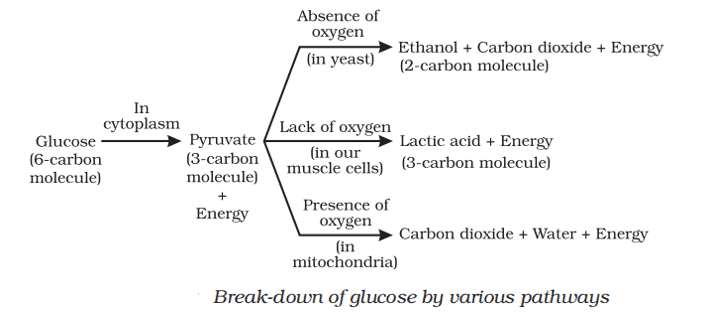
- The food material taken in during the process of nutrition is used in cells to provide energy for various life processes.
- Some use oxygen to break down glucose completely into carbon dioxide and water.
- Some use other pathways that do not involve oxygen.
- In all cases, the first step is the breakdown of glucose, a six-carbon molecule, into a three-carbon molecule called pyruvate. This process takes place in the cytoplasm.
- Anaerobic respiration:
- The pyruvate may be converted into ethanol and carbon dioxide. This process takes place in yeast during fermentation. Since this process takes place in the absence of air (oxygen), it is called anaerobic respiration.
- Aerobic respiration:
- The breakdown of pyruvate using oxygen takes place in the mitochondria. This process breaks up the three-carbon pyruvate molecule to give three molecules of carbon dioxide. The other product is water. Since this process takes place in the presence of air (oxygen), it is called aerobic respiration.
| Aerobic respiration | Anaerobic respiration |
| 1. Takes place in the presence of oxygen. | 1. Takes place in the absence of oxygen. |
| 2. Complete breakdown of food occurs in it. | 2. Incomplete breakdown of food occurs in it. |
| 3. The end products are Carbon dioxide and water. | 3. The end products are lactic acid or ethanol and Carbon dioxide. |
| 4. It takes place in the cytoplasm and inside mitochondria. | 4. It takes place in the cytoplasm only. |
| 5. More energy is released. | 5. Less energy is released. |
- Sometimes, when there is a lack of oxygen in our muscle cells, another pathway for the breakdown of pyruvate is taken. Here the pyruvate is converted into lactic acid which is also a three-carbon molecule. This build-up of lactic acid in our muscles during sudden activity causes cramps.
- Normally during day time, the rate of photosynthesis is much more than the rate of respiration. So, carbon dioxide produced during respiration is used up for photosynthesis hence carbon dioxide is not released.
- Terrestrial animals can breathe oxygen in the atmosphere, but animals that live in water need to use the oxygen dissolved in water.
- Since the amount of dissolved oxygen is fairly low compared to the amount of oxygen in the air, the rate of breathing in aquatic organisms is much faster than that seen in terrestrial organisms.
- Human respiratory system:
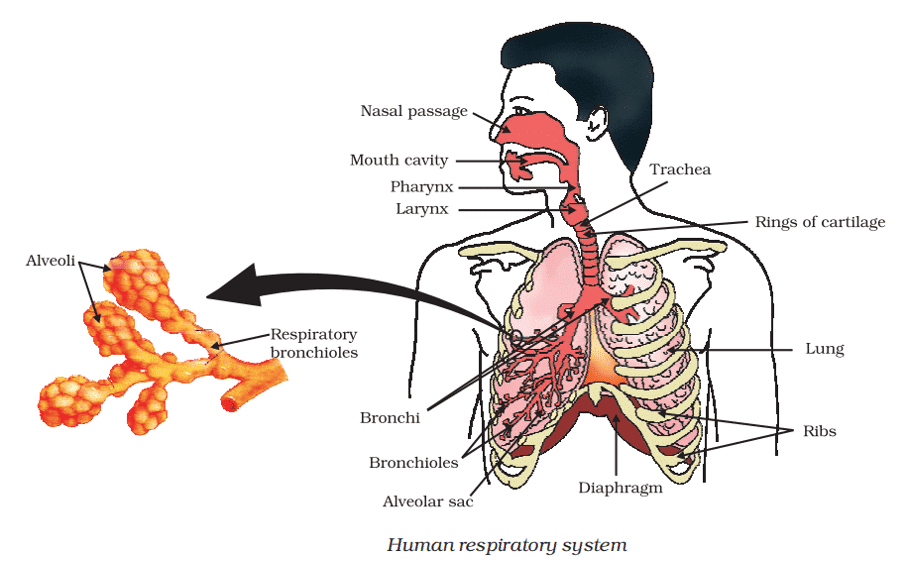
- The respiratory route of air in the respiratory tract of humans is the Nostrils → pharynx → larynx → trachea → alveoli.
- Rings of cartilage are present in the throat. These ensure that the air passage does not collapse.
- Within the lungs, the passage divides into smaller and smaller tubes which finally terminate in balloon-like structures which are called alveoli (singular–alveolus).
- Role of alveoli:
- The alveoli provide a surface where the exchange of gases can take place.
- The walls of the alveoli contain an extensive network of blood vessels. The blood brings carbon dioxide from the rest of the body for release into the alveoli, and the oxygen in the alveolar air is taken up by the blood in the alveolar blood vessels to be transported to all the cells in the body.
- In human beings, the respiratory pigment is hemoglobin which has a very high affinity for oxygen. This pigment is present in the red blood corpuscles.
- Carbon dioxide is more soluble in water than oxygen is and hence is mostly transported in the dissolved form in our blood.
Transportation
Transportation in Human Beings
- Blood transports food, oxygen, and waste materials in our bodies.
- Blood consists of a fluid medium called plasma in which the cells are suspended.
- Plasma transports food, carbon dioxide, and nitrogenous wastes in dissolved form.
- Oxygen is carried by the red blood corpuscles.
- We thus need -
- a pumping organ (heart) to push blood around the body,
- a network of tubes (arteries and veins) to reach all the tissues and
- a system in place (platelets) to ensure that this network can be repaired if damaged.
Our pump — the heart
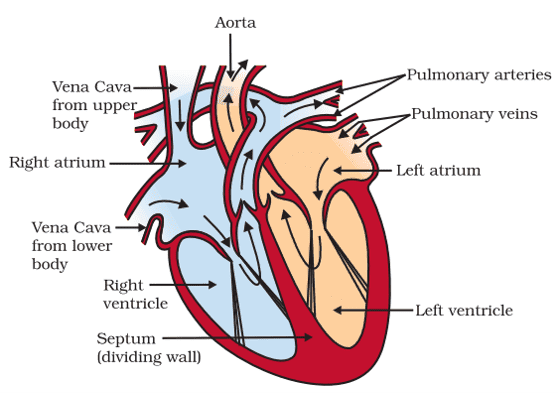
- Oxygen-rich blood from the lungs comes to the thin-walled upper chamber of the heart on the left, the left atrium.
- The left atrium relaxes when it is collecting this blood.
- It then contracts, while the next chamber, the left ventricle, relaxes, so that the blood is transferred to it.
- When the muscular left ventricle contracts in its turn, the blood is pumped out to the body.
- De-oxygenated blood comes from the body to the upper chamber on the right, the right atrium, as it relaxes.
- As the right atrium contracts, the corresponding lower chamber, the right ventricle, dilates.
- This transfers blood to the right ventricle, which in turn pumps it to the lungs for oxygenation.
- The separation of the right side and the left side of the heart is useful to keep oxygenated and deoxygenated blood from mixing. Such separation allows a highly efficient supply of oxygen to the body.
- Animals, like amphibians and many reptiles, have three-chambered hearts and tolerate some mixing of the oxygenated and de-oxygenated blood streams.
- Fishes, on the other hand, have only two chambers to their hearts, and the blood is pumped to the gills, is oxygenated there, and passes directly to the rest of the body.
Double circulatory system
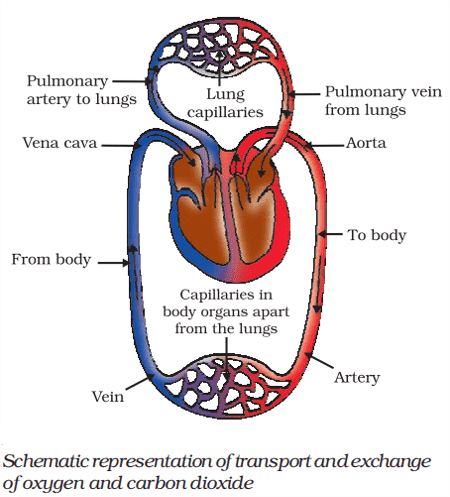
The oxygenated blood from the lungs returns to the heart, which is pumped again into different parts of the body by the heart. Thus, the blood passed twice through the heart making one complete round through the body, i.e., once through the right half in the form of deoxygenated blood and once through the left half in the form of oxygenated blood.
Blood Pressure
- Blood pressure is measured with an instrument called a sphygmomanometer.
- The force that blood exerts against the wall of a vessel is called blood pressure.
- This pressure is much greater in arteries than in veins.
- The normal systolic pressure is about 120 mm of Hg and diastolic pressure is 80 mm of Hg.
The tubes – blood vessels
| Artery | Vein |
| 1. Have thick, elastic, muscular walls. | 1. Have thin, non-elastic walls. |
| 2. Lumen is narrow. | 2. Lumen is wide. |
| 3. Carry blood from the heart to all body parts. | 3. Carry blood from all body parts to the heart. |
| 4. Carry oxygenated blood (except pulmonary artery). | 4. Carry deoxygenated blood (except pulmonary vein). |
| 5. Blood pressure is high. | 5. Blood pressure is low. |
Maintenance by platelets
In case of any leakage, the blood has platelet cells that circulate around the body and plug these leaks by helping to clot the blood at these points of injury.
Lymph
The functions of lymph in transportation are:
- Lymph carries digested and absorbed fat from the intestine back to the blood.
- Lymph drains excess fluid from extracellular space back into the blood.
Blockage of the lymphatic system will lead to water retention and poor fat absorption in the body.
| Blood | Lymph |
| 1. Red in color. | 1. Colorless. |
| 2. RBCs are present. | 2. RBCs are absent. |
| 3. Nutritive substances are more. | 3. Nutritive substances are less. |
| 4. Contains more oxygen. | 4. Contains less oxygen. |
| 5. Contains more protein. | 5. Contains less protein. |
| 6. Metabolic wastes and Carbon dioxide are in normal amounts. | 6. Both are more than blood. |
Transportation in Plants
- Plant transport systems will move energy stores from leaves and raw materials from roots.
- The xylem moves water and minerals obtained from the soil.
- Phloem transports products of photosynthesis from the leaves where they are synthesized to other parts of the plant.
Transport of water
- At the roots, cells in contact with the soil actively take up ions. This creates a difference in the concentration of these ions between the root and the soil. Water, therefore, moves into the root from the soil to eliminate this difference.
- Evaporation of water molecules from the cells of a leaf creates a suction that pulls water from the xylem cells of roots.
Transpiration
- The loss of water in the form of vapor from the aerial parts of the plant is known as transpiration.
- Transpiration helps in the absorption and upward movement of water and minerals dissolved in it from roots to the leaves.
- It also helps in temperature regulation.
Transport of food and other substances
- The transport of soluble products of photosynthesis is called translocation and it occurs in the part of the vascular tissue known as the phloem.
- Translocation in phloem is achieved by utilizing energy.
- Material like sucrose is transferred into phloem tissue using energy from ATP.
| Xylem | Phloem |
| Carries water & minerals from the roots to other parts of the plant | Carries product of photosynthesis from leaves to the other parts of the plant. |
| No energy is used. | Energy is used from ATP (adenosine triphosphate). |
Excretion
Excretion in Human Beings
The excretory system of human beings includes a pair of kidneys, a pair of ureters, a urinary bladder and a urethra.
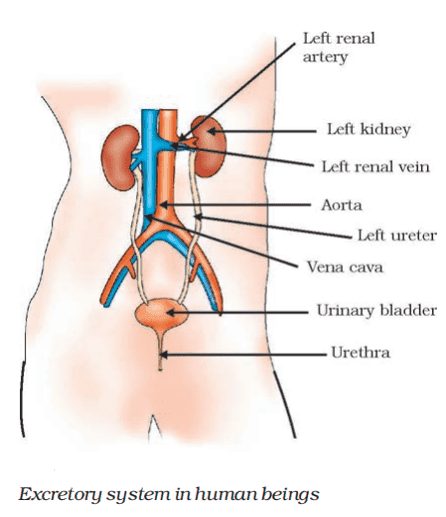
- The basic filtration unit in the kidneys is a cluster of very thin-walled blood capillaries.
- Each capillary cluster in the kidney is associated with the cup-shaped end of a coiled tube called Bowman’s capsule that collects the filtrate.
- Each kidney has large numbers of these filtration units called nephrons packed close together.
- Some substances in the initial filtrate, such as glucose, amino acids, salts, and a major amount of water, are selectively re-absorbed as the urine flows along the tube.
- The amount of water re-absorbed depends on:
- how much excess water there is in the body
- how much of dissolved waste there is to be excreted.
- Urine is stored in the urinary bladder until the pressure of the expanded bladder leads to the urge to pass it out through the urethra.
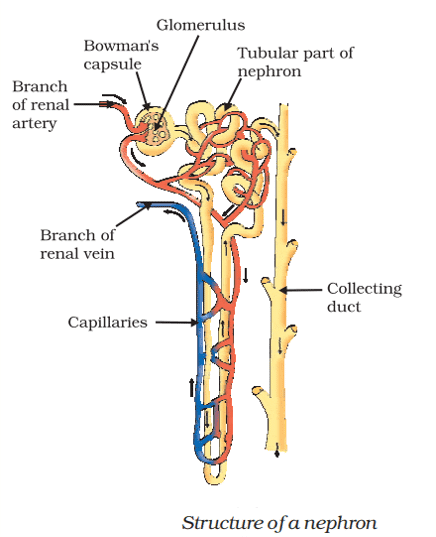
Haemodialysis : The process of purifying blood by an artificial kidney. It is meant for kidney failure patients.
Excretion in Plants
Plants use different strategies for excretion of different products:
- Oxygen and carbon dioxide are diffused through stomata.
- Excess water is removed by transpiration.
- Plants can even lose some of their old parts like old leaves and the bark of trees.
- Other waste products like raisins and gums especially in old xylem cells can also be lost by plants.
- Plants also secrete some waste substances into the soil around them.
Hope you liked these notes. Please share this with your friends and do comment if you have any doubts/suggestions to share.
Thnku u so much for such wonderful notes:)
It’s so nice note related to ncert, wonderful Boss
Wow wonderful notes
Give in mode if pdf please 🥺🥺
How to Download PDF from CBSE Guidance Website
https://youtu.be/zjocgf0LzUM
Sir jkbose notes
Sir pls 4 or 8 chapter ke notes bhi dal dijiye
Sir pls ch 4 or 8 ke bhi notes dal dijeye
Sir can please detail on your telegram account
Why do you need telegram?
Wonderful notes
Sir, NCERT se bahar bhi aayega topic or intext
detailed explaination of nephron is not given. its v imp.